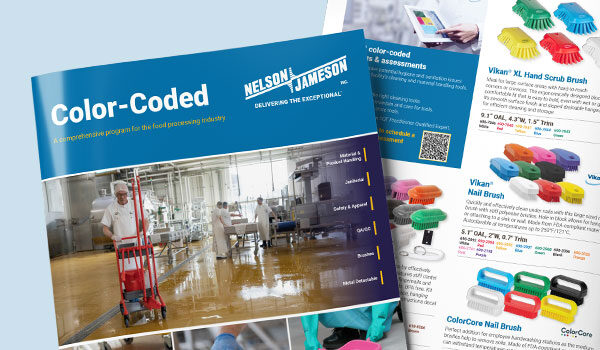
A well-designed color-coding system significantly enhances efficiency and safety, especially in industries like manufacturing, healthcare, and logistics. However, the effectiveness hinges not just on implementation but also on meticulous documentation and record-keeping of your color-coding system. A robust documentation strategy ensures consistency, facilitates training, provides a valuable reference point for audits, and supports continuous improvement.
This post explores why documentation is crucial, what records to maintain, and how tools like shadow boards enhance visual organization. Learn more about color coding with our complete guide!
Comprehensive documentation serves several key purposes:
Clarity and Consistency: Documented standards eliminate ambiguity and ensure everyone understands the meaning of each color. This is crucial for consistent application across the entire facility.
Training and Onboarding: Well-maintained documentation simplifies training for new employees and serves as a readily available reference for existing staff. It reduces reliance on tribal knowledge and ensures consistent messaging.
Auditing and Compliance: Detailed records are essential for internal and external audits. They demonstrate that the color-coding system is being implemented and maintained according to established procedures.
Continuous Improvement: Documentation provides a historical record of the system's evolution. This information can be invaluable for identifying areas for improvement and tracking the effectiveness of changes.
Troubleshooting and Problem Solving: When issues arise, documented procedures and historical data can help pinpoint the cause and facilitate quicker resolution.
Legal and Liability: In certain industries, documented safety procedures, including color-coding systems, can be crucial in demonstrating due diligence in case of accidents or incidents.
Contact us today to begin your color coding journey and improve food safety in your facility.

Here's a breakdown of the key documents and records you should maintain for your color-coding system:
Color Code Manual/Standard: This is the cornerstone. It should clearly define each color, its meaning, and its intended application. Include visual examples of how the colors are used on different types of equipment, labels, and signage. Consider a color palette chart with CMYK, RGB, and hexadecimal values.
Implementation Plan: Document the implementation steps, including timelines, responsibilities, and challenges. This is useful for future implementations or expansions.
Training Materials: Keep records of all training materials, including presentations, handouts, and videos. This ensures consistency and provides a review resource.
Training Records: Maintain records of employee training, including dates, participant names, and trainer signatures. This demonstrates that employees have received the necessary training.
Equipment/Area Inventory: Maintain an inventory of all equipment and areas where the color-coding system is used. This can be a spreadsheet or database linking each item to its corresponding color code.
Maintenance Logs: Keep records of maintenance activities on color-coded equipment, including dates, work performed, and technician signatures. This helps track maintenance history and identify patterns.
Inspection and Audit Records: Document all inspections and audits, including dates, findings, and corrective actions taken.
Incident Reports: Document any incidents or accidents related to the color-coding system thoroughly, including dates, times, locations, descriptions, and contributing factors.
System Updates and Revisions: Maintain a log of any updates or revisions, including dates, reasons, and updated documentation.
Shadow board Documentation: For shadow boards, document the following:
"A robust documentation strategy ensures consistency, facilitates training, provides a valuable reference point for audits, and supports continuous improvement."
Shadow boards are a powerful visual tool that complements a color-coding system. They provide a designated place for tools and equipment, making it easy to see what's missing and where everything belongs. Integrating shadow board documentation into your overall system provides several advantages:
Visual Inventory Control: At a glance, you can see if any tools or items are missing, reducing search time and improving inventory management.
Easy Replacement: Documented replacement procedures, linked to the shadow board layout and item list, streamline the process of ordering replacements for missing or damaged tools.
Improved Organization: Shadow boards promote a clean and organized workspace, reducing clutter and improving safety.
Accountability: Clearly defined locations for tools and equipment encourage accountability and responsible tool management.
Make it Accessible: Store documentation centrally, easily accessible to all relevant personnel. Consider a digital platform for easy access and version control.
Keep it Up-to-Date: Regularly review and update the documentation to ensure it accurately reflects the current state of the color-coding system and shadow boards.
Use Visuals: Incorporate images, diagrams, and other visual aids to make the documentation clear and easy to understand. This is especially important for shadow board layouts.
Standardize Formats: Use consistent templates and formats for all documents to ensure a professional and organized appearance.
Version Control: Implement a version control system to track changes to documents and prevent confusion caused by outdated information.
Regular Review: Conduct regular reviews of the documentation to ensure its accuracy and effectiveness.
By prioritizing documentation and record-keeping, including detailed information about your shadow boards, you can ensure that your color-coding system remains a valuable tool for improving safety, efficiency, and communication. It's an investment that pays off by providing clarity, consistency, and a solid foundation for continuous improvement.

Cassi is a Product Manager - MRO Products at Nelson-Jameson.

November 13, 2025
In the demanding field of occupational safety, protecting workers requires more than just offering equip...

November 12, 2025
For professionals who must maintain productivity and a secure grip in frigid conditions, the MCR Safety ...
.jpg)
November 12, 2025
In demanding, hygiene-sensitive environments like food manufacturing and dairy processing, effective pro...

Recognize and address possible hygiene and sanitation challenges based on the cleaning and material handling equipment available in your facility.
Through a discovery call, virtual, or on-site assessment, Vikan SQF Practitioner certified specialists will assist in confirming that your system and cleaning tool inventory aligns with your risk management objectives while pinpointing any missing tools and enhancing maintenance and usage practices. Evaluate whether your existing tools are utilized in the most effective manner, or determine if a more suitable tool exists for the task at hand. Ensure that your tools comply with all relevant standards and regulatory requirements. Site evaluations encompass a summary survey, an overview of the location, a color-coded factory layout plan, product suggestions, a recommended order form, and a proposal for a follow-up survey.
Food Safety, Sanitation, Cleaning Tools, Color Coding

This is a comprehensive program for the food processing industry. Nelson-Jameson brings together the most extensive collection of color-coded products for material handling, product handling, janitorial, safety, apparel, QA/QC, and metal-detectable applications. With the right pieces, a color-coding system is a powerful tool in preventing cross-contamination of allergens and food-borne illnesses that can lead to sickness or expensive product recalls.

Food Safety, Sanitation, Cleaning Tools, Color Coding

With existing and emerging threats, food safety has never been more important to food manufacturers in protecting their consumers and their organization.
Color Coding

Laboratory, Color Coding, Food Safety